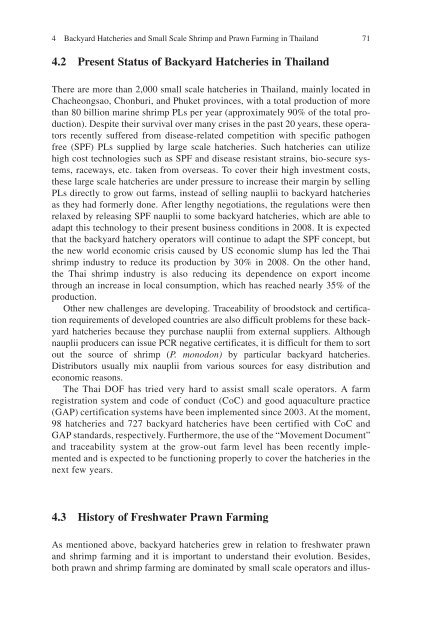Success Stories In Asian Aquaculture - Library - Network of ...
Success Stories In Asian Aquaculture - Library - Network of ...
Success Stories In Asian Aquaculture - Library - Network of ...
- No tags were found...
You also want an ePaper? Increase the reach of your titles
YUMPU automatically turns print PDFs into web optimized ePapers that Google loves.
4 Backyard Hatcheries and Small Scale Shrimp and Prawn Farming in Thailand714.2 Present Status <strong>of</strong> Backyard Hatcheries in ThailandThere are more than 2,000 small scale hatcheries in Thailand, mainly located inChacheongsao, Chonburi, and Phuket provinces, with a total production <strong>of</strong> morethan 80 billion marine shrimp PLs per year (approximately 90% <strong>of</strong> the total production).Despite their survival over many crises in the past 20 years, these operatorsrecently suffered from disease-related competition with specific pathogenfree (SPF) PLs supplied by large scale hatcheries. Such hatcheries can utilizehigh cost technologies such as SPF and disease resistant strains, bio-secure systems,raceways, etc. taken from overseas. To cover their high investment costs,these large scale hatcheries are under pressure to increase their margin by sellingPLs directly to grow out farms, instead <strong>of</strong> selling nauplii to backyard hatcheriesas they had formerly done. After lengthy negotiations, the regulations were thenrelaxed by releasing SPF nauplii to some backyard hatcheries, which are able toadapt this technology to their present business conditions in 2008. It is expectedthat the backyard hatchery operators will continue to adapt the SPF concept, butthe new world economic crisis caused by US economic slump has led the Thaishrimp industry to reduce its production by 30% in 2008. On the other hand,the Thai shrimp industry is also reducing its dependence on export incomethrough an increase in local consumption, which has reached nearly 35% <strong>of</strong> theproduction.Other new challenges are developing. Traceability <strong>of</strong> broodstock and certificationrequirements <strong>of</strong> developed countries are also difficult problems for these backyardhatcheries because they purchase nauplii from external suppliers. Althoughnauplii producers can issue PCR negative certificates, it is difficult for them to sortout the source <strong>of</strong> shrimp ( P. monodon) by particular backyard hatcheries.Distributors usually mix nauplii from various sources for easy distribution andeconomic reasons.The Thai DOF has tried very hard to assist small scale operators. A farmregistration system and code <strong>of</strong> conduct (CoC) and good aquaculture practice(GAP) certification systems have been implemented since 2003. At the moment,98 hatcheries and 727 backyard hatcheries have been certified with CoC andGAP standards, respectively. Furthermore, the use <strong>of</strong> the “Movement Document”and traceability system at the grow-out farm level has been recently implementedand is expected to be functioning properly to cover the hatcheries in thenext few years.4.3 History <strong>of</strong> Freshwater Prawn FarmingAs mentioned above, backyard hatcheries grew in relation to freshwater prawnand shrimp farming and it is important to understand their evolution. Besides,both prawn and shrimp farming are dominated by small scale operators and illus-
















